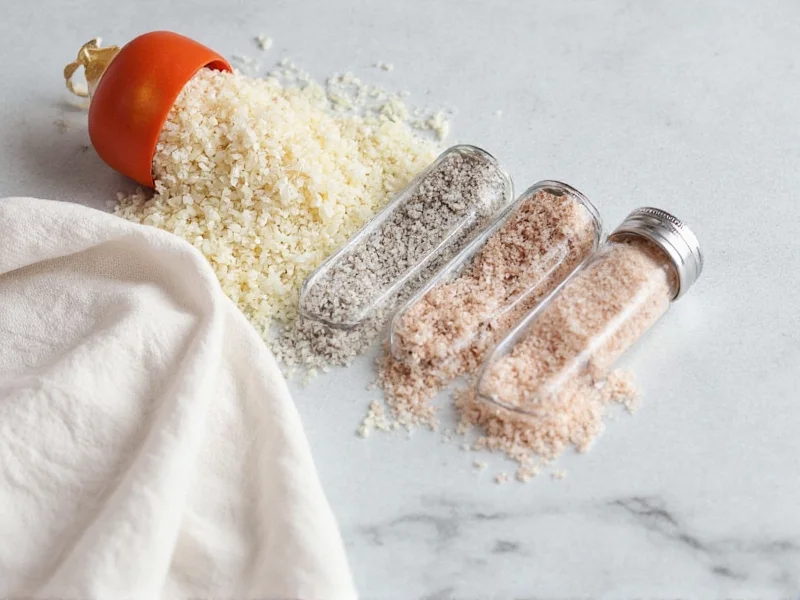Reducing sodium intake is essential for millions managing hypertension, heart disease, or kidney conditions. With the average American consuming 3,400 mg of sodium daily—far exceeding the American Heart Association's recommended 1,500 mg limit—finding practical low sodium salt alternatives becomes critical for long-term health. This guide examines scientifically supported options that deliver flavor without compromising cardiovascular wellness.
Why Sodium Reduction Matters
Excessive sodium consumption directly impacts blood pressure levels. Research published in the New England Journal of Medicine demonstrates that reducing daily sodium intake to 1,500 mg can lower systolic blood pressure by 5-6 mm Hg in hypertensive individuals. For those exploring low sodium salt substitutes for hypertension management, understanding which alternatives provide genuine sodium reduction—not just marketing claims—is essential.
Science-Backed Low Sodium Alternatives
Potassium Chloride Substitutes
Potassium chloride-based products replace 65-70% of sodium chloride with potassium. Brands like Morton Salt Substitute and NoSalt contain 0 mg sodium per ¼ tsp. While some detect a slight metallic aftertaste, newer formulations have significantly improved palatability. Important consideration: Those with kidney disease or taking ACE inhibitors should consult physicians before using potassium-based alternatives.
Herb and Spice Blends
Crafting sodium-free seasoning options using dried herbs provides complex flavor without sodium. Effective combinations include:
- Mediterranean blend: Rosemary, thyme, oregano, garlic powder
- Southwest mix: Cumin, smoked paprika, chili powder, cilantro
- Herbes de Provence: Lavender, marjoram, savory, tarragon
These healthy alternatives to table salt enhance dishes while providing antioxidant benefits. A study in the Journal of Food Science found herb-infused foods rated equally flavorful as high-sodium versions in blind taste tests.
Citrus and Acidic Enhancers
Lemon, lime, and vinegar activate taste receptors similarly to salt. Try these techniques:
- Add 1-2 tsp lemon juice per serving to roasted vegetables
- Use rice vinegar in Asian-inspired dishes instead of soy sauce
- Finish soups with a splash of sherry vinegar
Acidity creates the perception of saltiness without sodium, making this approach ideal for reducing sodium in cooking naturally.
Umami Powerhouses
Foods rich in glutamate provide savory depth that reduces salt dependency:
- Mushroom powder (blend dried shiitakes in spice grinder)
- Nutritional yeast (½ tsp replaces ¼ tsp salt)
- Tomato paste (concentrated umami for sauces)
- Seaweed flakes (kombu adds subtle ocean flavor)
| Alternative | Sodium Reduction | Taste Profile | Best Applications |
|---|---|---|---|
| Potassium chloride | 100% | Slightly metallic | Cooking, baking, general use |
| Herb blends | 100% | Earthy, aromatic | Meats, vegetables, dressings |
| Citrus juices | 100% | Bright, acidic | Fish, salads, grains |
| Umami ingredients | 100% | Savory, deep | Soups, sauces, stews |
| Himalayan pink salt | 0% | Mineral-forward | Finishing only (same sodium as table salt) |
Practical Implementation Strategies
Transitioning to low-sodium cooking requires adjustment. Implement these evidence-based techniques:
Gradual Reduction Method
Decrease salt by 25% initially while increasing herbs. Within 6-8 weeks, your taste buds adapt to lower sodium levels. Research from the Monell Chemical Senses Center confirms this neurological adaptation occurs faster than previously believed.
Layering Technique
Add flavor enhancers at multiple cooking stages:
- Initial cooking: Aromatics (onion, garlic, celery)
- Middle phase: Acidic components (tomatoes, wine)
- Finishing: Fresh herbs, citrus zest, vinegar
Reading Labels Critically
When shopping for sodium-free seasoning options, watch for:
- "Sea salt" or "Himalayan salt" (same sodium content as table salt)
- "Reduced sodium" claims (may still contain significant sodium)
- Hidden sodium in spice blends (check for sodium benzoate)
Important Health Considerations
While exploring best salt alternatives for heart health, remember:
- Potassium-based substitutes require medical clearance for kidney patients
- "Natural" salts like Celtic sea salt contain identical sodium levels to table salt
- Some salt substitutes contain bitter blockers that may affect medication absorption
- Complete sodium elimination isn't recommended—small amounts support nerve function
Avoiding Common Misconceptions
Many believe "lite salt" products offer significant sodium reduction. In reality, most contain 50% sodium chloride and 50% potassium chloride—still delivering substantial sodium. True low sodium salt alternatives for hypertension management must contain minimal or zero sodium chloride. Similarly, "no salt added" claims only indicate no salt was added during processing—the product may still contain naturally occurring sodium.
Creating Lasting Flavor Habits
Developing sustainable low-sodium cooking practices involves retraining your palate. Start by replacing just one high-sodium ingredient per meal with a flavorful alternative. Within weeks, previously acceptable salty foods will taste overpowering. This neurological adaptation, documented in Physiology & Behavior journal, makes maintaining lower sodium intake progressively easier.
Frequently Asked Questions
Can potassium chloride salt substitutes lower blood pressure?
Yes, when used as complete sodium replacements, potassium chloride substitutes can significantly reduce sodium intake. Research shows potassium may also have mild blood pressure-lowering effects, though those with kidney conditions should consult doctors before use.
Do herb blends really replace salt's flavor function?
Yes, when properly formulated. Herbs contain volatile compounds that stimulate different taste receptors than salt. Studies show trained palates cannot distinguish between properly seasoned low-sodium dishes and high-sodium versions after several weeks of adaptation.
Is Himalayan pink salt actually lower in sodium?
No, all salt varieties including Himalayan pink salt, sea salt, and kosher salt contain approximately 40% sodium by weight. The trace minerals in colored salts don't reduce sodium content, though they may provide subtle flavor differences.
How long does it take to adjust to low-sodium cooking?
Most people adapt within 6-8 weeks. Research from the Monell Center shows taste bud sensitivity to salt decreases during this period, making previously normal salt levels taste excessively salty. Gradual reduction improves long-term adherence.











 浙公网安备
33010002000092号
浙公网安备
33010002000092号 浙B2-20120091-4
浙B2-20120091-4